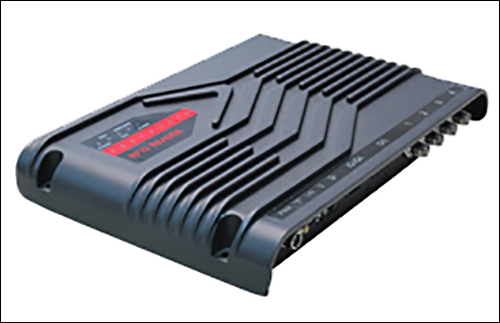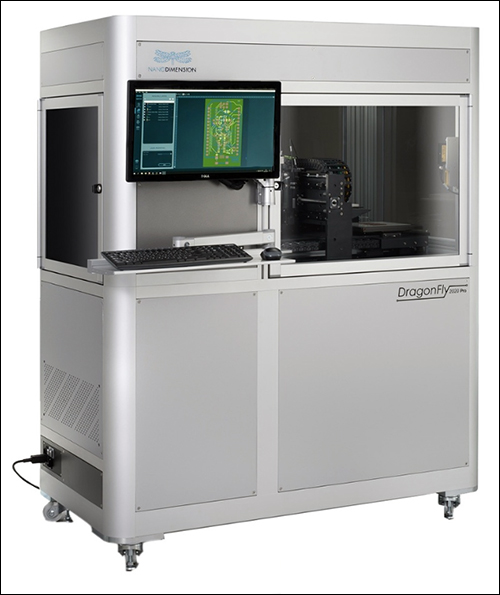Nov 15, 2018Presented here are news announcements made during the past week by the following organizations:
CDO Technologies, Brady Corp.;
Daily RFID;
Harris Corp., Nano Dimension;
FogHorn, Dell EMC OEM Solutions; and
CoreRFID.
CDO Technologies, Brady Corp. Intro RFID Asset-Tracking System
Businesses that have historically been unable to afford large-scale asset tracking now have access to customizable solutions as a result of a partnership between Brady Worldwide and CDO Technologies. The combination of Brady's CenSys and CDO's Critical Asset Tracking Solution (CATS) is intended to help businesses locate items and lower infrastructure costs, according to the two companies.
"The benefits of RFID asset tracking are well known, but it hasn't always been accessible for smaller companies," said Al Wofford, CDO Technologies' founder and president, in a prepared statement. "The options we're providing now are customizable and scalable, allowing businesses to compete more effectively with the big players in manufacturing, healthcare, and service industries."
"Typical fixed RFID readers can be quite expensive, often costing several thousand dollars s per reader. Combine that with infrastructure and software needs, and the overall cost investment becomes simply too much for most small to medium businesses," said Wesley Columbia, Brady's global strategy and marketing manager, in the prepared staement. "Requiring only power and a Wi-Fi connection, CenSys has been specifically designed to offer great performance and value at the sub-$1,000 price point while also being simple to install and configure."
The CenSys reader detects the presence and unique identity of passive UHF RFID tags within its field of view, then feeds this information into CATS. The CenSys and CATS combination can connect to a cloud-based or on-premises server. CATS collects data to track asset movement, conduct inventories or monitor work-in-process. Stored data can be integrated with other enterprise systems to construct financial analytics, measure production efficiencies or validate logistical operations.
Because this solution can be based in a cloud-computing environment, the companies explain, businesses can reduce infrastructure costs by eliminating the need for onsite servers and custom software. Lower equipment costs can also be achieved with the strategic placement of readers. "Many customers don't need complete coverage of their facility," Columbia said. "Instead, the last known location provides sufficient relevant data to update their customers or manage high-value items."
For example, multiple lines, finishing processes or manual processes complicate monitoring work-in-progress components, but readers placed at specific production points can make the tracking process smoother. An operator can log into the system to access information and update a customer. Tool tracking is also an application for which expensive or frequently used tools can be tagged, with a series of readers placed in a tool crib or on a workbench. This can reduce the amount of downtime that workers spend searching for missing tools, or the expense of replacing those tools.
"Measurable ROI is definitely important to organizations," said Robert Zielinski, CDO Technologies' director of commercial solutions, in the prepared statement. "By combining an RFID reader with modern Internet of Things processing technology and a dedicated RFID asset-tracking software, we can open up new opportunities for more companies to become efficient and profitable at the same time."
Daily RFID Unveils New Fixed UHF RFID Reader
DAILY RFID has released its new UHF High Performance Fixed Reader. According to the RFID manufacturer, the new reader can connect with four antennas to cover a wide area.
The reading distance of each antenna is up to 30 meters (98 feet), the company reports, and the system can read more than 400 pieces of tags simultaneously. The device comes with a developer's kit and various programming languages, including VC++, Delphi, C#, VB.net and VB 6.0. DAILY RFID can customize the programming language upon request.

The reader supports electronic article surveillance (EAS) systems and can scan EAS tags. It is suitable for asset-tracking solutions, the company reports, due to the reader's high anti-collision capability. The solution can monitor movements, record events in real time, and provide access control and warehouse management.
Harris Corp. Creates RF Amplifiers Using Nano Dimension 3D Printer
In the area of additive manufacturing for printed electronics, tests conducted by Harris Corp. have shown that the performance of its 3D printed radio frequency (RF) circuit is comparable to that of circuits developed using conventional manufacturing techniques. Harris says it will present the full details of its findings at the IEEE Radio and Wireless Symposium, to be held in January. The firm has selected additive electronics provider Nano Dimension's multi-material DragonFly Pro 3D electronics printer to produce functional circuits in a single print.
The study, which measured the advantages of using additive manufacturing to develop RF circuits for wireless systems, was conducted as part of a joint project with the Israel Innovation Authority and the Space Florida Foundation, a partnership promoting research, development and the commercialization of aerospace and technology projects.

Harris develops RF circuits for electronic warfare and communications systems. In developing circuits and systems for conveying information, such as data, video and voice across long distances, Harris says it has focused on improving mobility and performance. It has also focused on reducing the time required for development, which is typically a long, complex, multi-stage process with conventional manufacturing methods, the company reports.
"Harris looked at the applicability of 3D printing for developing RF systems, and then designed, simulated and tested the 3D printed RF amplifier and compared it with an amplifier fabricated using conventional manufacturing techniques," said Arthur Paolella, a senior scientist for space and intelligence systems at Harris Corp., in a prepared statement. "Our results showed similar RF performance between the 3D printed version and the baseline amplifier, clearly demonstrating the viability of 3D printed electronics for RF circuitry."
"The use of in-house 3D printed electronics to make antennas is a breakthrough, in terms of the time and cost of prototyping and proofs-of-concept," said Amit Dror, Nano Dimension's CEO, in the prepared statement. "In addition, 3D printed electronics makes possible development of even smaller and lighter antennas that have rigid packaging integrated with flexible circuits, without the need for cables and connectors."
The Nano Dimension DragonFly Pro is a multi-material inkjet deposition 3D printing system that incorporates conductive silver inks and dielectric inks to create functional electronic parts in a single print. In June 2017, Nano Dimension received an Israel Innovation Authority grant approval to finance a project to develop 3D printing of electronical modules, in collaboration with Harris, for space applications. The grant project was designed to demonstrate that 3D-printing double-sided, multilayer circuits that distribute digital and RF signals could reduce the size, weight, power and cost of space systems.
The DragonFly 2020 Pro 3D printer, according to Harris, is designed to let businesses take control of their development cycle. The system allows the 3D printing of functional electronics, such as encapsulated sensors, conductive free-form geometries, antennas, molded connected devices, printed circuit boards and other devices.
FogHorn, Dell EMC OEM Solutions Partner on Industrial IoT Edge Computer
FogHorn, a developer of edge-intelligence software for industrial and commercial Internet of Things (IoT) applications, has announced a collaboration with Dell EMC OEM Solutions to provide Industrial IoT (IIoT) edge-computing solutions.
This collaboration allows industrial and commercial customers to leverage edge technologies quickly with an out-of-the-box solution for their IIoT deployments, providing real-time insights to streamline operations and improve business outcomes. FogHorn's edge-intelligence solution will be made available on Dell hardware through the Dell IoT Solutions Partner Program, starting next month.
By integrating FogHorn's Lightning edge-computing solution with Dell EMC's technology, the partners report, industrial and commercial customers can access preconfigured gateways and other devices designed to simplify IoT deployments. These solutions allow clients to deploy edge computing at various end-point locations quickly, according to the two companies.
"With more than 75 billion IoT connected devices predicted to be installed by 2025, making technology to manage and process the data collected from these devices crucial," said Ron Pugh, Dell EMC OEM Solutions' VP and general manager for the Americas, in a prepared statement. "FogHorn enables our end-point and gateway products to become smart edge solutions by layering their edge intelligence directly into our hardware, driving insights at any point in their IoT deployments."
"By teaming up with Dell as a trusted leader for hardware in the IoT space, FogHorn positions itself as the go-to provider of edge intelligence for commercial and industrial IoT deployments," said Kevin Duffy, FogHorn's VP of business development, in the prepared statement. "Customers now have access to a best-in-class solution to simplify and streamline their IoT deployments, which allows them to unleash the power of their data so they can get to results more quickly."
CoreRFID Buys Out Investor Coalfields Enterprise Fund
CoreRFID, a U.K.-based company that designs electronic tracking systems, reports that it has completed a six-figure buyout. The deal provides an exit for its original investor, The Coalfields Enterprise Fund, and allows the management team to take full control of its business.
CoreRFID uses radio frequency identification technology to track assets, vehicles, product deliveries, legal files and more. The company, located in England, serves an international client base including the London Underground, ICL and BAE Systems, as well as supermarkets and law firms. Mercia Fund Managers, the fund's parent company, backed CoreRFID at its launch in 2007, and has since provided follow-on investment rounds to support its growth. CoreRFID's management team—Munzi Ali, Richard Harris and Terry Allen—bought out part of Mercia's stake in 2016 and have now acquired the remaining shares.
"Setting up in business just before the credit crunch was not the most auspicious start and the first few years were tough," Allen said in a prepared statement. "However Mercia supported us every step of the way, not only by providing funding but also practical advice and support. In recent years we have achieved a step change in the business and are now well placed to move forward as an independent. We already have a very strong presence in construction and manufacturing, and as advances in technology open up new opportunities in sectors such as professional services and entertainment, we are firmly focused on expansion."
"CoreRFID's experience shows that tech start-ups need patient, long-term, investors like Mercia which can support them at each stage of their development," said Paul Taberner, Mercia's investment director, in the prepared statement. "As the business is now firmly established, we wish the team all the best in exploiting the considerable opportunities ahead."

